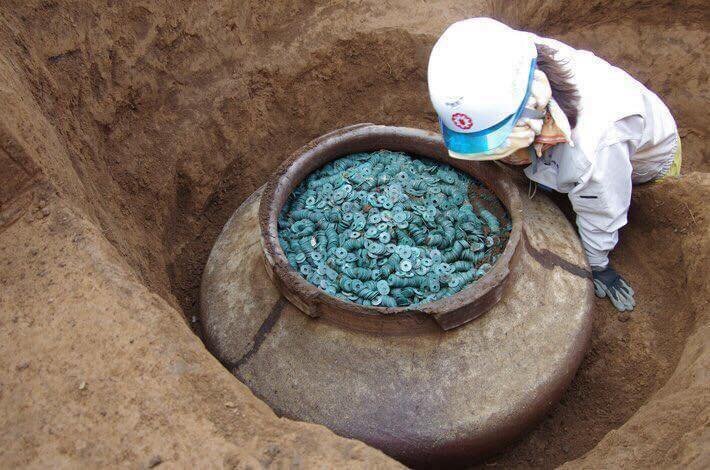
(Courtesy Saitama Cultural Deposits Research Corporation)
According to archaeologist Yoshiyuki Takise of the Saitama Cultural Deposits Research Corporation, the coins, which were cast in China, may have been an offering to the deity of the earth or simply buried for safekeeping.
Markings on a wooden tablet found on the rim of the jar indicate it could contain as many as 260,000 coins, a number that Takise says far exceeds what one would expect to find in circulation in what was then a rural area.

Ohara-tei (Site of Old Samurai Residence)
(侍) were the hereditary military nobility and officer caste of medieval and early-modern Japan from the 12th century to their abolition in the 1870s. They were the well-paid retainers of the daimyo (the great feudal landholders). They had high prestige and special privileges such as wearing two swords. They cultivated the bushido codes of martial virtues, indifference to pain, and unflinching loyalty, engaging in many local battles. During the peaceful Edo era (1603 to 1868), they became the stewards and chamberlains of the daimyo estates, gaining managerial experience and education. In the 1870s, samurai families comprised 5% of the population. The Meiji Revolution ended their feudal roles, and they moved into professional and entrepreneurial roles. Their memory and weaponry remain prominent in Japanese popular culture.
The fortune of a Japanese samurai was discovered by archaeologists in the Saitama Prefecture near Tokyo in August of 2018 and has been named the largest haul of medieval coins ever found in Japan.
The coins were found in a large, two-foot-wide ceramic jar dating back to the fifteenth century. The copper in the bronze coins found inside has turned bright green due to the natural oxidation process of verdigris.
The jar had been buried over six feet deep, possibly to hide the warrior’s riches, which were in danger due to the civil unrest in Japan at the time.
Found by archaeologists. Credit: Shoichi Tanaka
The coins, which have an opening in the center, were strung on a rope and included a few varied coins from China’s Ming and Tang dynasties. In total, the archaeologists who found the hoard believe there are over one hundred thousand coins, but a wooden tablet buried along with the coins may provide more information.
Read also: There is a theory that the city of Troy was located in England and the Trojan War was fought between groups of Celts.
Including the Japanese words, “nihyakurokuju” for the number 260 could refer to the measurements of 260 kan, which are units of one thousand and would identify that there are two hundred and sixty thousand coins in the jar.
According to gainesvillecoins.com, a string of one thousand coins was worth one ounce of silver and was a common amount to keep on one’s person. During the time when the coins were buried, the country was divided and ruled by an Emperor who gave conquered lands to the Shoguns, military leaders.
The Muromachi Period from 1333 to 1573 AD refers to the Ashikaga Shogunate, which saw a war between Ashikaga Takauji and his brother Tadayoshi that lasted for two years, with Ashikaga Takauji emerging as the victor. It was at this time that most of the rules for samurai behavior were enacted.
Read also: From the Thracians to the Vikings, a celebration of the drinking horn.
The samurai were an elite guard of soldiers that swore their lives to the daimyo, a sort of land-holding military governor for the area in which he lived. They held bravery, honor, and personal loyalty above their own lives and would commit seppuku, a ritual self-disembowelment, rather than suffer dishonor.
They were identified by the two swords presented to them by a military leader and were well-paid with special perks.
Kamei Koremi, a daimyo during the Bakumatsu period.
With all of the civil unrest as daimyos began feuding with each other, the Warring States period from 1467-1568 AD was a time of fighting, murders, and deceit among Japan’s rival daimyo warlords and samurai over who would become the next Shogun – a member of the Hosokawa family or a member of the Yamanaka family.
Read also: Patrick Stewart, prepared to play Data in “Star Trek: The Next Generation,” was reluctant to audition for the captain.
Since the power of the Shogun was diminished during this time, it really didn’t matter and may have been an excuse for the over-aggressive daimyos to flaunt their power.
There were no victors and nothing was accomplished after it was over, although the ordinary civilians were subject to lawlessness, brutality, and extreme hardship.
Some good came from this period as slavery was almost completely abolished, and art and architecture flourished as warlords began building castles to protect themselves from invasion.
They were placed at mountain passes and on large estates with moats and other medieval protections. Omi-Hachiman castle near Lake Biwa in Shiga Prefecture drew enough people that a small town was established around the castle.
The Japanese tea ceremony was popularized at this time by Buddhist monks, and the Zen religion brought out artists such as the Zen priest Sesshu/Toyo, whose works are still considered some of the best art to come out of Japan.
Ancient.eu tells us that when the warlord Oda Nobunaga began conquering different parts of the country, he eventually was able to take the capital, Heiankyo, in 1568 AD and exiled Ashikaga Yoshiaki in 1573 AD.
Another Article From Us: Ghost Hunters Captures Image of ‘Phantom Soldier on Horseback’
Nobunaga helped to unify central Japan until his death in 1582 AD, and his efforts were carried on by his successors, Toyotomi Hideyoshi who ruled from 1537-1598 AD and Tokugawa Ieyasu who was Shogun from 1543-1616 AD and began to open trade with the West. The coins are now on display at the Saitama Prefecture’s cultural treasury in Kumagaya.